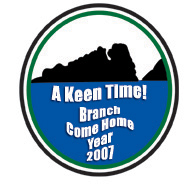


|
Branch Come Home Year August 9-19, 2007 |

|
1959 English Invasion of Branch Submitted by: Terry Fletcher |
|
Many people who lived in Branch in the summer of 1959 will remember the arrival there of five students from England. Since that time, I have made several visits back and numerous people have reminded me of that summer, but do not know why we came and why I have returned so often – though many have said I must have found gold up Looney’s River!
We were undergraduates of Durham University in north-east England and members of our university Exploration Society. Each summer vacation, members were encouraged to organize study-visits abroad to exercise and improve our knowledge of our particular fields of study as well as to enjoy a healthy vacation.
In 1958, an expedition organized by the School of Agriculture visited Greenland to study the first stages of soil growth, i.e., what happens to the ground when the ice melts. In 1959, the school wished to continue the study by visiting an area that contained the next stage of soil development, i.e., a region that had been ice-free longer than Greenland. Newfoundland was chosen as an ideal area.
Four agricultural students were to carry out the main soil study, while I, as a geology student, was included as the advisor on the composition of the local rocks involved in the process of soil growth. Jim Egan was the leader of the expedition and responsible for our general well-being; Keith Syers was the main analyzer of the soil profiles, whilst Neil Taylor and Peter Johnson were to assist him on related topics like the local influence of plants and animals in the formation of soil types.
Initially, our plan was to study the soils of the Codroy Valley. However, that plan was drastically changed on arrival in the Province. We traveled from England on an iron-ore boat from Middlesbrough to Bell Island, where Customs Canada confiscated all our meat and fat food. This really upset our plans for the Codroy Valley, because we had to buy a new supply of food, thus greatly depleting our finances – we could no longer afford to cross the island.
Jim decided to seek the help of the Ministry of Agriculture in the partly built Confederation Building. Pat Murray put us up under the care of Ron Kelsey of Kilbride who took us to see Bob Chancy at the federal Mount Pearl Research Station. He suggested that Branch and the Cape Shore would be a good area within reasonable distance of St. John’s, particularly since not much was known of the soils and rocks down there. Pat Murray arranged for us to be transported to Branch and to be transported back to Bell Island for our return home once our studies were over. Arriving in Branch on a sunny mid-June day, we enquired around for permission to camp on someone’s property. The ever-friendly Bridie at the post office opposite Leo English’s store took us to her home, where Miss Kate and Mr. Jim Downey fed us and gave permission to camp in Downey’s Meadow out along the Low Road. We had tents, but the old hay shed on the hill was the preferred choice of the four agrics, but I wanted to camp in a tent and that turned out to be a very bad decision on my part. I set up my tent down at the stream and that night I was eaten alive by the flies.
Our general plan was to study the soils on the Flats, on cleared ground, e.g., the Bare Patch, and on the wet boglands. Since there were no maps of the Cape St. Mary’s Peninsula rocks, I had to go out into the country to see what rock types there are. This meant a lot of travelling on my own, but I was trying to stay fit for the football season, so it worked out well for me – better than digging holes like the others had to do.
After many days walking up fly-infested rivers like Branch, Beckford, Red Head and Looney’s, I accumulated many fly bites and soon developed blood poisoning with very swollen glands. Eventually, I had to seek the help of a nurse and luckily Sadie English was able to tend to me and send me on to Placentia Cottage Hospital, where they shaved off my half-grown beard and painted me purple. After penicillin and four days in a hospital bed under Dr.Collingwood, I was released in good health to find my way back to Branch. It was a hot day and I walked the old gravel road as far as Little Barachois, where Mrs. Foley called me over for a bite to eat, before I carried on my walk. In those days, there was little traffic and it was not until I got to Ship Cove that Mr. Tobin, on his way home from Labrador, gave me a lift as far as his home at Cuslett Lookout. From there I walked on to Sadie and Nicky Murphy’s for another bite to eat. That was a day to remember.
The day after my return to Branch was the Garden Party at Patrick’s Cove, when Leo English crowded us into his car with some of the Branch girls. That was our first garden party and well remembered.
Those days in Branch are unforgettable; they were our fist real touchdown with Canada and we really enjoyed them. The Branch boys perhaps didn’t take to us at first and teased us continually with the playing and singing of the current song WATERLOO, when the sound of “We fought the bloody British at the Battle of New Orleans” was heard through open windows from every record-player in the community- especially from Bridie Downey’s. By the end of July, we had been invited into most houses and had survived on fresh fish and newly-baked bread kindly given from many homes, notably from the Kate and Jackie Mooney house. Memories of those days not only include the garden parties, but also the Rita English Wedding and housie-housie before a film show in the old Church Hall on the hill. However, the best memories are of the nightly sing songs and dancing on the wooden bridge, when Keith played Stephen English’s guitar.
Our stay in Branch ended at the beginning of August when we moved to St. Bride’s to study soils there. People may remember the St. Bride’s Garden Party when Fr. Lawlor asked us to play our music at the dance with Miss Kate Downey on her squeeze-box.
On our return to university, Keith wrote his honours BSc thesis on his Cape Shore findings that eventually led to his PhD and a long academic life –he became the youngest professor in the School of Agriculture. Peter returned to finish his degree and join his father in running their very large farm. Neil got his degree and decided on a career in teaching, whilst Jim went on to become the University Farm Manager.
For my part, I owe much to the time I have spent on the Cape Shore and Branch. My PhD study at Cambridge of the trilobite fossils I found in the Easter Cove has allowed me to visit many rock sections around the world and to discuss their importance in understanding the Cambrian World over 500 million years ago. I continue to publish this work that will establish the fossiliferous rock sequence in the Easter and Wester Coves of Branch as one of the most important Cambrian localities in the world.
The visit this year coincides with the imminent publication by the Geological Survey of Newfoundland and Labrador of my 1:50 000-scale map of the rocks of the Cape St. Mary’s Peninsula and its accompanying explanatory book. At the end of September, the folk of Branch may have seen several government vehicles in Wester Cove; they had brought members of the Geological Association of Canada to admire the fossils there, but, because of the wet and windy conditions, we were not able to see too much and were not able to appreciate fully their importance. Hopefully, they will be seen in better weather in the future. Throughout my days spent in the Branch Country, I have been lucky enough to enjoy the kindness, hospitality and generosity of Branch, especially that given to me by Lizzie and Dougie Nash when I almost became a member of the family and therefore a Branch citizen.
|
